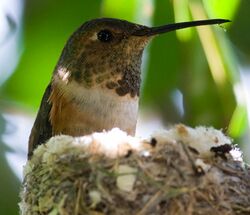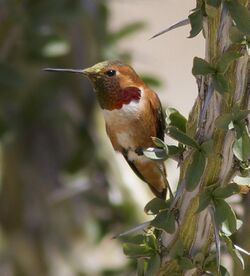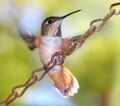Biology:Allen's hummingbird
| Allen's hummingbird | |
|---|---|
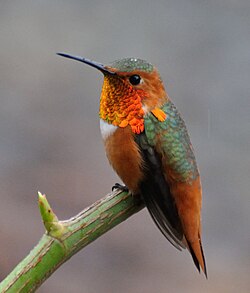
| |
| Adult male | |
| Scientific classification | |
| Domain: | Eukaryota |
| Kingdom: | Animalia |
| Phylum: | Chordata |
| Class: | Aves |
| Clade: | Strisores |
| Order: | Apodiformes |
| Family: | Trochilidae |
| Genus: | Selasphorus |
| Species: | S. sasin
|
| Binomial name | |
| Selasphorus sasin (Lesson, RP, 1829)
| |
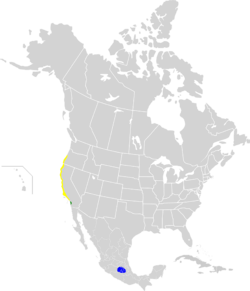
| |
| Range of S. sasin Breeding range Year-round range Wintering range
| |
Allen's hummingbird (Selasphorus sasin) is a species of hummingbird that breeds in the western United States. It is one of seven species in the genus Selasphorus.
Description
Allen's hummingbird is a small bird, with mature adults reaching only 3 to 3.5 in (76 to 89 mm) in length and about 2 to 4 grams in weight.[3] The male has a green back and forehead, with rust-colored (rufous) flanks, rump, and tail. The male's throat is an iridescent orange-red. The female and immature Allen's hummingbirds are similarly colored, but lack the iridescent throat patch, instead having a series of speckles on their throats. Females are mostly green, featuring rufous color only on the tail, which also has white tips. Immature Allen's hummingbirds are so similar to the female rufous hummingbird, the two are almost indistinguishable in the field. The lack of a notch in the second rectrix (R2) is considered an important field mark to distinguish the adult male Allen's hummingbird from rufous hummingbird, particularly the hard to distinguish green-backed variety.[4] Both species' breeding seasons and ranges are common factors used to differentiate between the two species in a particular geographical area.
Taxonomy
Allen's hummingbird was formally described by the French naturalist René Lesson in 1829 and given the binomial name Ornismya sasin.[5] The specific epithet is a Wakashan or Nootka Native American name for a hummingbird.[6] The type locality is San Francisco.[7] Allen's hummingbird is now placed in the genus Selasphorus that was introduced by William Swainson in 1832.[8][9] The common name commemorates Charles Andrew Allen, an American collector and taxidermist who identified the bird in 1879 in Nicasio, California.[10]
Two subspecies are recognised:[9]
- S. s. sasin (Lesson, R, 1829) – breeds south Oregon and California (USA), winters in south central Mexico
- S. s. sedentarius Grinnell, 1929 – islands off south California (USA)
A hybrid between this species and Anna's hummingbird has been described as Floresi's hummingbird, "Selasphorus" floresii.[11][12]
Distribution
Allen's hummingbird is common only in the brushy woods, gardens, and meadows of coastal California from Santa Barbara north, and southern coastal Oregon. The nominate race, S. s. sasin, is migratory, and in southern central Mexico. Male and female migratory patterns do not match - the males head back north first at the beginning months of the year, while the females arrive closer to spring, preparing to breed.[13] A second, S. s. sedentarius, is a permanent resident on the Channel Islands off southern California.[14] This population colonized the Palos Verdes Peninsula of Los Angeles County in the 1960s and has since spread over much of Los Angeles and Orange Counties, south through San Diego County, and east to the western end of Riverside County. The elevations in which these birds breed vary, peaking at around 1,000 feet.[3] As the nominate race lives in a restrictive range, it is increasingly threatened by human actions and habitat loss. This impact is documented through their population decline. In the last fifty years, the Allen's hummingbird has lost about 83% of its population. However, the birds have began adapting to their affected areas by feeding from invasive plants and bird feeders.[13]
Behavior
The courtship flight of male Allen's hummingbirds is a frantic back-and-forth flight arc of about 25 ft (7.6 m) similar to the motion of a swinging pendulum, followed by a high-speed dive from about 100 ft (30 m) during which tail feathers emit a characteristic sharp flutter to further attract attention of the female.[15] Aggressive and territorial, male Allen's hummingbirds will chase any other males from their territory, as well as any other hummingbird species, and have even been known to attack and rout predatory birds several times larger than themselves, such as kestrels and hawks. After mating, the male does not stay and help the female raise the young.[16] Both male and females utilize high-pitched vocalizations in familial and territorial social settings.[13]
Females tend to reside in forests with large trees, such as oak-pine, Douglas Fir, and redwood, providing ample protection and nest material.[3] Allen's hummingbird constructs its nest out of plant fibers, down, and weed stems, coating the nest with lichens and spider webs to give it structure. This process is gradual, taking about a week to build a nest of adequate size.[3] The nest is placed above ground on a tree branch or the stalk or stem of a plant. The female lays one or two white eggs, which she incubates for 15 to 17 days. The young leave the nest about three weeks after hatching. The mother continues to feed the fledglings for several more weeks, then the young are left to fend for themselves. When females create new nests, they often utilize their old one; some move the previous nest's materials to another location and start anew, while others simply spruce up their original designs.[3]
Like all hummingbirds, Allen's hummingbird's high rate of metabolism requires it to feed frequently. It drinks nectar from flowers and eats any small insects (such as flies, ants, small beetles, spiders, and tiny wasps) in flight or on flower blossoms, providing needed protein.[3][17] Additionally, the Allen's hummingbird's pollination supports and protects many plants, such as the endangered Western Lily.[13]
Gallery
References
- ↑ BirdLife International (2018). "Selasphorus sasin". IUCN Red List of Threatened Species 2018: e.T22688299A131283791. doi:10.2305/IUCN.UK.2018-2.RLTS.T22688299A131283791.en. https://www.iucnredlist.org/species/22688299/131283791. Retrieved 12 November 2021.
- ↑ "Appendices | CITES". https://cites.org/eng/app/appendices.php.
- ↑ 3.0 3.1 3.2 3.3 3.4 3.5 "Allen's Hummingbird Life History, All About Birds, Cornell Lab of Ornithology" (in en). https://www.allaboutbirds.org/guide/Allens_Hummingbird/lifehistory.
- ↑ Pyle, Peter (1997). Identification Guide to North American Birds, Part I: Columbidae to Ploceidae. Steve N. G. Howell, Siobhan Ruck, Institute for Bird Populations, Point Reyes Bird Observatory. Bolinas, Calif.: Slate Creek Press. ISBN 0-9618940-2-4. OCLC 38593534. https://www.worldcat.org/oclc/38593534.
- ↑ Lesson, René P. (1829) (in French). Histoire Naturelle des Oiseaux-Mouches. Paris: Arthus Bertrand. pp. xxx–xxxi, 190–193, Plates 66, 67. https://www.biodiversitylibrary.org/page/49416227.
- ↑ Jobling, James A. (2010). The Helm Dictionary of Scientific Bird Names. London: Christopher Helm. p. 348. ISBN 978-1-4081-2501-4.
- ↑ Peters, James Lee, ed (1945). Check-List of Birds of the World. 5. Cambridge, Massachusetts: Harvard University Press. p. 142. https://www.biodiversitylibrary.org/page/14480153.
- ↑ Swainson, William John; Richardson, J. (1831). Fauna boreali-americana, or, The zoology of the northern parts of British America. Part 2. The Birds. London: J. Murray. p. 324. https://www.biodiversitylibrary.org/page/41549739. The title page bears the year 1831 but the volume did not appear until 1832.
- ↑ 9.0 9.1 Gill, Frank; Donsker, David; Rasmussen, Pamela, eds (January 2021). "Hummingbirds". IOC World Bird List Version 11.1. International Ornithologists' Union. http://www.worldbirdnames.org/bow/hummingbirds/.
- ↑ Bendire, Charles (1895). Life Histories of North American Birds, from the Parrots to the Grackles. Washington, DC, USA: U.S. Government Printing Office. p. 217. https://www.biodiversitylibrary.org/page/14375709.
- ↑ Ridgway, Robert (1909). "Hybridism and generic characters in the Trochilidae". Auk 26 (4): 440–442. doi:10.2307/4071292. http://sora.unm.edu/sites/default/files/journals/auk/v026n04/p0440-p0442.pdf.
- ↑ Taylor, Walter P. (1909). "An instance of hybridization in hummingbirds, with remarks on the weight of generic characters in the Trochilidae". Auk 26 (3): 291–293. doi:10.2307/4070800. http://sora.unm.edu/sites/default/files/journals/auk/v026n03/p0291-p0293.pdf.
- ↑ 13.0 13.1 13.2 13.3 "Allen's Hummingbird" (in en). https://abcbirds.org/bird/allens-hummingbird/.
- ↑ Clark, C.J.; Mitchell, D.E. (2020). Poole, A.F.. ed. "Allen's Hummingbird (Selasphorus sasin), version 1.0". Birds of the World (Ithaca, NY, USA: Cornell Lab of Ornithology). doi:10.2173/bow.allhum.01. https://doi.org/10.2173/bow.allhum.01. Retrieved 16 February 2021.
- ↑ Clark, C. J. (2014). "Harmonic hopping, and both punctuated and gradual evolution of acoustic characters in Selasphorus hummingbird tail-feathers". PLOS ONE 9 (4): e93829. doi:10.1371/journal.pone.0093829. PMID 24722049. Bibcode: 2014PLoSO...993829C.
- ↑ "Allen’s Hummingbird" (in en-US). https://celebrateurbanbirds.org/learn/birds/hummingbird/allens-hummingbird/.
- ↑ "Allen's hummingbird". Animal Diversity Web, Department of Zoology, University of Michigan. 2020. https://animaldiversity.org/accounts/Selasphorus_sasin/. Retrieved 21 October 2023.
External links
- Live Allen's hummingbird nest webcam at Phoebe Allen's Hummingbird Webcam
- "Allen's hummingbird media". Internet Bird Collection. http://www.hbw.com/ibc/species/allens-hummingbird-selasphorus-sasin.
- Gallery of Allen's Hummingbirds in flight taken with high speed flash
- Allen's hummingbird photo gallery at VIREO (Drexel University)
- BirdLife species factsheet for Selasphorus sasin
- "Selasphorus sasin". Avibase. https://avibase.bsc-eoc.org/species.jsp?lang=EN&avibaseid=.
Wikidata ☰ Q1262651 entry
 |

